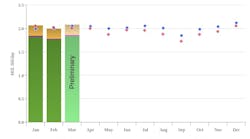High electric prices are getting headlines. But consumers are just beginning to feel the bite from rising natural gas prices.
The average wellhead price of natural gas is expected to average $3.03/mcf in 2000, the highest projected annual inflation-adjusted price since 1985.Many gas and electric utilities have begun filing requests for pass-through increases for higher gas prices with state utility commissions.
With gas storage levels down, compared to a year ago, government experts say natural gas prices could stay high until the spring of 2001.
The Energy Information Agency "anticipates that prices will be high through the summer and into the winter, as gas demand growth for electric generation is projected to remain high through 2000," Mary J. Hutzler, director of the office of integrated analysis and forecasting for the Energy Information Administration, told the US Senate Committee on Energy and Natural Resources.
Several years of relatively low prices and high storage levels slowed exploration and drilling for new supply. Bu the July natural gas rig count hit a high of 718 rigs on June 30 as natural gas producers responded to higher prices.
However, the positive impact of the increase in activity in the form of increased production will not come until after the winter heating season. Meanwhile, Hutzler told Congress EIA expects Canadian imports to help alleviate a tight supply situation this winter.
Last year, natural gas consumption was more than 21 tcf and accounted for 23% of US energy consumption. The EIA is forecasting natural gas consumption will rise about 1.8%/year between now and 2020, or faster than any other fuel thanks to the growth of natural gas-fired electric generation. Gas use by electricity generation is expected to increase more than 2� times, compared to current levels, while modest growth is projected for all other fuel uses, Hutzler said.
More gas is also being used as electric generation plants previously dedicated to peaking service have now been pressed into service for base load demand, she explained.
With prices providing the economic incentive and generally declining drilling costs, she said, successful lower-48 natural gas well completions are expected to reach 16,200 in 2015. While below the 1981 level of more than 20,000 gas wells, the number represents a 54% increase over 1998 levels, she said.
New pipelines under construction will help relieve congestion in Rocky Mountain region and improve access to customers, Hutlzer explained, while recent Gulf Coast area projects have increased gathering system capability and short-haul pipeline access to new supplies.
